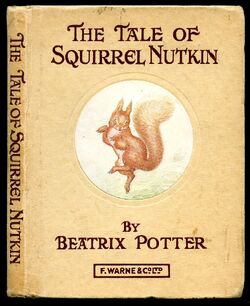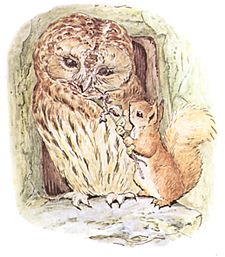
Front cover of a 1963 edition of The Tale of Squirrel Nutkin.
The Tale of Squirrel Nutkin is a children's fantasy story by the British author and illustrator Beatrix Potter. It was first published in August 1903. It was the second of Potter's children's books to be commercially published,[1] following the success of The Tale of Peter Rabbit. The Tale of Squirrel Nutkin is adapted from an illustrated letter that Beatrix Potter wrote to a girl named Norah Mooore, the daughter of Potter's former governess Anne Moore, in 1901.
In a similar manner to the Just-So Stories of Rudyard Kipling, The Tale of Squirrel Nutkin attempts to explain the origin of some animal behavior. The story's title character is a cheeky squirrel who irritates an owl named Old Brown by repeatedly asking him riddles which Old Brown has no interest in answering. Eventually, Old Brown becomes so angry with Squirrel Nutkin that the squirrel is lucky to escape with his life.
A segment based on The Tale of Squirrel Nutkin is included in the 1971 Royal Ballet film Tales of Beatrix Potter.[2]
The character of Squirrel Nutkin is also briefly referred to in Potter's 1905 book The Tale of Mrs. Tiggy-Winkle.
Plot[]
Squirrel Nutkin is a red squirrel who lives with his brother Twinkleberry and several other squirrels in a wood at the edge of a lake. In the center of the lake is an island called Owl Island. There is a hollow tree on the island which is home to an owl known as Old Brown.

Old Brown and Squirrel Nutkin. Original illustration by Beatrix Potter.
In the autumn, the squirrels make rafts and sail over to Owl Island to gather nuts. They go there each day for six consecutive days. Squirrel Nutkin joins them, although he spends more of his time on the island playing than collecting nuts. Each day, the majority of the squirrels very politely ask Old Brown's permission to gather nuts on the island. Each day, they bring him a present. They bring him three fat mice on the first day, a fat mole on the second day, seven fat minnows on the third day, six fat beetles wrapped in leaves on the fourth day, some wild honey on the fifth day and a new-laid egg on the sixth day. Unlike the other squirrels, Nutkin does not treat Old Brown with great respect. Each day, Squirrel Nutkin annoys Old Brown by singing riddles to him. Old Brown takes no interest in riddles. He does not attempt to answer them and ignores Squirrel Nutkin.
On the sixth day, Squirrel Nutkin sings three riddles to Old Brown. When the owl does not respond to any of them, Squirrel Nutkin jumps onto the owl's head. The furious Old Brown takes Squirrel Nutkin into his house. He holds the squirrel by his tail, intending to skin him. Squirrel Nutkin struggles to break free, breaking his tail in two in the process, and manages to escape.
Squirrel Nutkin now hates riddles. If anyone looks up into Nutkin's tree and asks him a riddle, the squirrel will throw sticks, stamp his feet and make an angry noise.
Footnotes[]
- ↑ Although The Tale of Squirrel Nutkin was the second of Beatrix Potter's children's books to be commercially published, The Tailor of Gloucester was first published privately some nine months earlier in December 1902.
- ↑ Other segments in the 1971 film Tales of Beatrix Potter are based on The Tale of Mrs. Tiggy-Winkle, The Tale of Two Bad Mice, The Tale of Johnny Town-Mouse, The Tale of Jemima Puddle-Duck, The Tale of Mr. Jeremy Fisher, The Tale of Pigling Bland and The Tale of Peter Rabbit.
